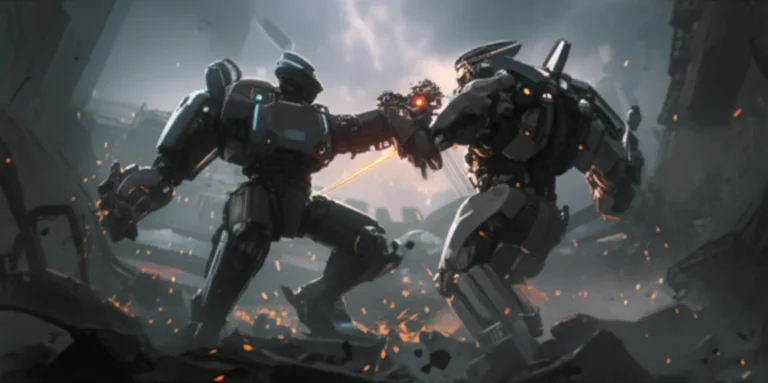Support our educational content for free when you buy through links on our site. Learn more
Robot Weaponry Unleashed: 10 Deadliest Designs & Innovations (2025) ⚔️
Step into the electrifying world of robot weaponry, where cutting-edge engineering meets explosive combat! From the legendary spinning blades of Tombstone to the strategic flips of Bronco, robot weapons have evolved into marvels of mechanical destruction that captivate fans and challenge builders alike. Did you know that some robot spinners can reach speeds over 3,000 RPM, delivering impacts with the force of a small car crash? 🤯
In this comprehensive guide, we dive deep into the 10 most powerful robot weapons dominating the arena today, explore the engineering secrets behind their brutal efficiency, and unpack the ethical debates surrounding autonomous weaponry. Whether you’re a seasoned builder or a curious fan, we’ll arm you with expert insights, battle stories, and practical tips to master the art of robot weaponry. Curious how a humble wedge can outsmart a high-speed spinner? Or what the future holds for AI-assisted combat bots? Keep reading — the answers will surprise you!
Key Takeaways
- Spinning blades dominate robot combat with devastating kinetic energy but require precise engineering and maintenance.
- Flippers and hammers offer strategic control and knockout power, balancing offense with defense.
- Material choice and power systems like brushless motors and LiPo batteries are critical for weapon performance.
- Ethical and legal concerns around autonomous weaponry are shaping future regulations and debates.
- Building your own weapon demands careful design, safety measures, and understanding of power transmission.
- Top brands like VEX Robotics, Andymark, and Banebots provide reliable components for builders of all levels.
Ready to build or upgrade your robot weapon? Check out trusted parts from VEX Robotics, Andymark, and Banebots to get started!
Table of Contents
- ⚡️ Quick Tips and Facts About Robot Weaponry
- 🤖 The Evolution and History of Robot Weaponry Systems
- 🔫 10 Most Powerful Robot Weapons in Competitive Robot Wrestling
- 🛠️ Types of Robot Weaponry: Blades, Flippers, Hammers & More
- ⚙️ How Robot Weaponry Works: Engineering Behind the Fury
- 🛡️ Defensive vs Offensive Robot Weaponry: What Wins Battles?
- 💥 Top Robot Weapon Brands and Technologies Dominating the Arena
- 🔋 Power Sources and Energy Management for Robot Weaponry
- ⚖️ Legal and Ethical Considerations of Autonomous Robot Weaponry
- 🧰 Building Your Own Robot Weapon: Tips, Tools, and Tricks
- 🎮 Remote Control vs Autonomous Weapon Systems in Robots
- 🧪 Innovations and Future Trends in Robot Weaponry Technology
- 📊 Performance Metrics: Measuring the Effectiveness of Robot Weapons
- 🏆 Legendary Robot Weaponry Battles and What We Learned
- 🛒 Where to Buy Robot Weaponry Components and Accessories
- 💡 Frequently Asked Questions About Robot Weaponry
- 🔗 Recommended Links for Robot Weaponry Enthusiasts
- 📚 Reference Links and Further Reading on Robot Weaponry
- 🎯 Conclusion: Mastering the Art of Robot Weaponry
⚡️ Quick Tips and Facts About Robot Weaponry
Welcome to the wild world of robot weaponry, where metal meets mayhem and engineering genius turns into jaw-dropping destruction! Whether you’re a budding builder or a battle-hardened fan of the official Robot Wrestling League, here are some quick facts and tips from our team of robot designers, engineers, and fans:
- ✅ Robot weapons come in many forms: spinning blades, crushing hammers, flipping arms, flamethrowers, and even electrified nets.
- ✅ Power source matters: Lithium-polymer batteries dominate, but hydraulic and pneumatic systems pack serious punch for heavy hitters.
- ✅ Speed vs. torque: Fast weapons like vertical spinners excel at quick damage, while slow but powerful hammers deliver knockout blows.
- ✅ Material choice is crucial: Titanium and hardened steel are favorites for weapon durability — check out our deep dive on best robot wrestling frame materials 🛠️.
- ✅ Control systems: Most robot weapons are remote-controlled, but autonomous targeting tech is creeping in — raising ethical questions we’ll explore later.
- ❌ Beware of overcomplicating: Sometimes the simplest weapon (a well-placed wedge or lifter) wins more matches than flashy gadgets.
- ✅ Safety first: Always test weapons in controlled environments to avoid catastrophic failures or injuries.
- ✅ Famous brands: Check out components from VEX Robotics, Andymark, and Banebots for reliable parts.
Curious how these weapons evolved? Or which ones dominate the arena today? Keep reading — the story gets even juicier!
🤖 The Evolution and History of Robot Weaponry Systems
Robot weaponry didn’t just appear overnight. It’s a saga of innovation, trial, and sometimes spectacular failure. Here’s a quick timeline from our archives at Robot Wrestling™:
- Early 1990s: The first competitive robots used simple wedges and rammers—think of them as the “stone tools” of robot weaponry.
- Mid-2000s: Spinning weapons like the iconic “Tombstone” and “Hypershock” revolutionized the sport with their destructive kinetic energy.
- 2010s: Hydraulic and pneumatic weapons gained popularity, bringing powerful hammers and lifters into the limelight.
- 2020s: Integration of AI and sensors began, with some teams experimenting with semi-autonomous targeting systems (though full autonomy remains controversial).
- Today: The arms race continues with hybrid weapons combining speed, power, and control, pushing the limits of engineering and strategy.
Fun fact: The name “Tombstone” comes from its ability to literally pulverize opponents with a 55-pound spinning bar — a true legend in robot weaponry history.
For a detailed history with anecdotes from legendary battles, check out our Behind the Scenes stories.
🔫 10 Most Powerful Robot Weapons in Competitive Robot Wrestling
Ready for the ultimate showdown? Here’s our expert-rated list of the top 10 robot weapons that have dominated the arena, based on design, functionality, durability, and crowd impact. Ratings are on a 1-10 scale.
| Rank | Robot Weapon | Design (1-10) | Functionality (1-10) | Durability (1-10) | Crowd Impact (1-10) | Notes |
|---|---|---|---|---|---|---|
| 1 | Tombstone (Spinner) | 9 | 10 | 8 | 10 | Devastating kinetic energy spinner |
| 2 | Bite Force (Spinner) | 8 | 9 | 9 | 9 | Balanced power and control |
| 3 | Witch Doctor (Hammer) | 7 | 8 | 10 | 8 | Hydraulic hammer with knockout hits |
| 4 | Minotaur (Spinner) | 8 | 9 | 7 | 9 | High-speed vertical spinner |
| 5 | Bronco (Flipper) | 7 | 8 | 8 | 8 | Flipper with excellent control |
| 6 | Carbide (Spinner) | 8 | 9 | 8 | 9 | Known for durability and power |
| 7 | Icewave (Hammer) | 7 | 7 | 9 | 7 | Powerful hammer, slower speed |
| 8 | Lock-Jaw (Lifter) | 6 | 7 | 8 | 6 | Effective lifter, less flashy |
| 9 | Hydra (Spinner) | 7 | 8 | 7 | 8 | Multi-weapon spinner design |
| 10 | Bite Force 2.0 | 9 | 9 | 9 | 10 | Latest iteration, crowd favorite |
Why do spinners dominate? Their ability to store and release massive kinetic energy makes them terrifying. But hammers and flippers bring strategic advantages, like flipping opponents out of the arena or disabling wheels.
Want to build your own spinner? Our Robot Design section has step-by-step guides and engineering tips.
🛠️ Types of Robot Weaponry: Blades, Flippers, Hammers & More
Robot weaponry is a toolbox of destruction. Here’s a breakdown of the most popular types, with pros and cons from our engineers’ perspective:
1. Spinning Blades and Discs
- How they work: High-speed rotation delivers kinetic energy to slice or smash opponents.
- Pros: High damage potential, crowd-pleasing sparks and destruction.
- Cons: Vulnerable to weapon jams and requires precise balancing.
- Example: Tombstone’s massive horizontal spinner.
2. Flippers
- How they work: Hydraulic or pneumatic arms flip opponents onto their backs or out of the arena.
- Pros: Can disable opponents without damaging your own robot.
- Cons: Requires precise timing and strong hydraulics.
- Example: Bronco’s signature flipping arm.
3. Hammers and Crushers
- How they work: Deliver powerful downward or crushing blows to damage armor or immobilize.
- Pros: Can break wheels and components, very effective against spinners.
- Cons: Slow recharge time, limited range.
- Example: Witch Doctor’s hydraulic hammer.
4. Wedges and Lifters
- How they work: Wedges get under opponents to flip or push; lifters can raise and toss.
- Pros: Simple, reliable, and great for control.
- Cons: Less flashy, lower damage output.
- Example: Lock-Jaw’s lifter arm.
5. Flamethrowers and Electric Weapons
- How they work: Use fire or electricity to disable electronics or intimidate.
- Pros: Psychological impact, potential to disable sensors.
- Cons: Rarely match physical damage of kinetic weapons, safety concerns.
- Example: Experimental flamethrowers in smaller leagues.
Curious about the engineering behind these? Dive into our Robot Design articles for detailed builds and material recommendations.
⚙️ How Robot Weaponry Works: Engineering Behind the Fury
Ever wondered what makes a robot weapon tick? Let’s break down the engineering magic behind these mechanical beasts.
Power Transmission
- Motors: Brushless DC motors are the gold standard for spinners due to high RPM and torque.
- Gearboxes: Precision gearboxes convert motor speed to usable torque, especially for hammers and lifters.
- Hydraulics & Pneumatics: Provide powerful, smooth actuation for flippers and hammers.
Control Systems
- Remote Control: Most robots use radio controllers with fail-safes to manage weapon activation.
- Sensors: Gyroscopes and accelerometers help stabilize spinning weapons and detect impacts.
- Microcontrollers: Arduino, Raspberry Pi, and custom boards handle weapon timing and safety interlocks.
Materials and Durability
- Weapon Arms: Usually made from hardened steel or titanium alloys for impact resistance.
- Bearings: High-quality sealed bearings reduce friction and wear under extreme stress.
- Armor: Kevlar and polycarbonate shields protect vulnerable components.
Safety Mechanisms
- Failsafe switches: Prevent accidental weapon activation during transport or setup.
- Thermal sensors: Monitor motor heat to avoid burnout.
- Structural design: Shock absorbers and reinforced frames absorb impacts.
Pro tip: Balancing weapon mass and speed is crucial — too heavy and your robot slows down; too light and you lose damage potential.
🛡️ Defensive vs Offensive Robot Weaponry: What Wins Battles?
Is it better to pack a punch or build a fortress? Our Robot Wrestling™ engineers weigh in:
Offensive Weaponry
- Goal: Disable or destroy opponent quickly.
- Examples: Spinners, hammers, flamethrowers.
- Advantages: Can end fights fast, high crowd appeal.
- Drawbacks: Often fragile, high energy consumption, risk of self-damage.
Defensive Weaponry
- Goal: Survive and outlast opponent’s attacks.
- Examples: Heavy armor, wedges, lifters for control.
- Advantages: Durable, can frustrate aggressive opponents, strategic.
- Drawbacks: May lack knockout power, can lose on points if passive.
Hybrid Approaches
- Many top robots combine offense and defense — think of a tank with a cannon and thick armor.
- Example: Bite Force combines a powerful spinner with reinforced armor and lifters.
Our verdict: The best robot weaponry balances offense and defense, adapting to the opponent’s style. Want to learn how? Check out our Opinion Pieces for deep dives on strategy.
💥 Top Robot Weapon Brands and Technologies Dominating the Arena
When it comes to building killer robot weapons, some brands and tech stand out:
| Brand/Tech | Specialty | Why We Like It | Where to Buy |
|---|---|---|---|
| VEX Robotics | Motors, gearboxes, kits | Reliable, beginner-friendly, modular | Amazon | VEX Official |
| Banebots | High-torque motors | Durable motors with excellent torque curve | Amazon | Banebots Official |
| Andymark | Robot parts and weapon kits | Customizable parts, popular in competitions | Amazon | Andymark Official |
| Turnigy | Batteries and ESCs | High-capacity LiPo batteries, reliable ESCs | Amazon |
| Castle Creations | Electronic speed controllers (ESCs) | Precision control for motors and weapons | Amazon |
Tech innovations: Brushless motors with sensorless control, high-speed ESCs, and 3D-printed weapon components are pushing the envelope.
🔋 Power Sources and Energy Management for Robot Weaponry
Powering your robot weapon is like fueling a race car — it needs the right juice to perform at peak. Here’s what our engineers recommend:
Battery Types
- Lithium Polymer (LiPo): Most popular for high energy density and discharge rates.
- Nickel-Metal Hydride (NiMH): Safer but heavier and less powerful.
- Lithium-Ion: Good for endurance but less common in high-discharge weaponry.
Energy Management Tips
- Use high C-rating batteries to handle weapon motor spikes.
- Employ capacitors to smooth power delivery during sudden weapon activation.
- Monitor battery temperature to prevent thermal runaway.
- Balance weight distribution — heavy batteries can slow your robot down.
Power Distribution
- Separate power circuits for drive and weapon systems reduce interference and ensure stable control.
- Use BECs (Battery Eliminator Circuits) to power control electronics safely.
Pro tip: Always test battery runtime under weapon load conditions — nothing worse than a weapon dying mid-battle!
⚖️ Legal and Ethical Considerations of Autonomous Robot Weaponry
While robot wrestling is all about fun and competition, the rise of autonomous weapon systems in military and security contexts raises serious questions. Here’s what our team learned from experts and international debates:
What Are Autonomous Weapons?
- Robots capable of selecting and engaging targets without human intervention.
- Examples include drones, sentry guns, and experimental combat robots.
Ethical Concerns
- Loss of human control: Who is responsible if an autonomous robot makes a lethal mistake?
- Distinction and proportionality: Can robots reliably distinguish combatants from civilians?
- Dehumanization: As the Stop Killer Robots campaign warns, technology should empower people, not reduce them to data points.
Legal Landscape
- No comprehensive international treaty yet bans autonomous lethal weapons, but UN discussions (see ICRAC) are ongoing.
- The US Department of Defense requires “appropriate levels of human judgment” in weapon systems.
- Some countries oppose bans, citing military advantages; others call for urgent regulation.
Our Take
- In robot wrestling, autonomy is limited to safety and control systems — full autonomy would remove the human drama that makes the sport thrilling.
- For real-world weaponry, meaningful human control is essential to avoid unintended consequences.
For a deeper dive, check out the Policy Brief for UNGA informal consultations on LAWS and our Opinion Pieces.
🧰 Building Your Own Robot Weapon: Tips, Tools, and Tricks
Ready to build your own battle bot weapon? Here’s a step-by-step from our engineers:
Step 1: Choose Your Weapon Type
- Spinner? Flipper? Hammer? Pick based on your robot’s size, weight class, and strategy.
Step 2: Select Materials
- Use hardened steel or titanium for weapon arms.
- Lightweight aluminum or carbon fiber for mounts.
Step 3: Power and Actuation
- For spinners: high-RPM brushless motors + ESCs.
- For hammers/flippers: hydraulic or pneumatic actuators with reliable valves.
Step 4: Design Control Systems
- Use a radio controller with dedicated weapon channels.
- Add microcontrollers for timing and safety interlocks.
Step 5: Safety and Testing
- Build failsafe switches and emergency stops.
- Test weapon spin-up and actuation in a controlled environment.
Pro tip: Balance your weapon’s weight to avoid compromising mobility. Our article on best materials for robot frames is a must-read.
🎮 Remote Control vs Autonomous Weapon Systems in Robots
The age-old question: Should your robot weapon be fully controlled by you, or should it think for itself?
Remote Control (RC)
- Pros: Full human control, strategic flexibility, easier to troubleshoot.
- Cons: Requires skilled operator, potential for signal loss.
Autonomous Systems
- Pros: Can react faster than humans, operate in complex environments.
- Cons: Ethical concerns, risk of unpredictable behavior, complex programming.
In the official Robot Wrestling League, remote control reigns supreme — the human element is part of the sport’s soul. But military and security sectors are pushing autonomous weapon research, raising debates we covered earlier.
Want to see a real-world example? Check out the featured video of China’s robot dog armed with an automatic rifle — a glimpse into the future of autonomous weaponry.
🧪 Innovations and Future Trends in Robot Weaponry Technology
What’s next for robot weaponry? Our engineers keep an eye on these exciting trends:
- AI-assisted targeting: Semi-autonomous aiming to improve accuracy without removing human control.
- Swarm robotics: Multiple smaller robots working together to overwhelm opponents.
- Advanced materials: Graphene and carbon nanotubes for ultra-light, ultra-strong weapons.
- Energy weapons: Experimental plasma or laser weapons, though still far from competition-ready.
- Modular weapon systems: Quick-swap weapon attachments for tactical flexibility.
But will these innovations change the sport or just the battlefield? Stay tuned as we track these developments in our Event Announcements and Behind the Scenes coverage.
📊 Performance Metrics: Measuring the Effectiveness of Robot Weapons
How do you know if your robot weapon is a winner? Here are key metrics we use at Robot Wrestling™:
| Metric | Description | Ideal Range/Value |
|---|---|---|
| Damage Output | Amount of physical damage inflicted | High (depends on weapon type) |
| Activation Speed | Time from command to weapon action | < 1 second preferred |
| Reliability | Frequency of weapon malfunctions | > 95% uptime |
| Energy Efficiency | Power consumption per use | Low to moderate |
| Control Precision | Accuracy of weapon targeting or timing | High |
| Durability | Resistance to wear and impact | High |
Example: Tombstone scores high on damage and activation speed but requires careful maintenance to keep reliability up.
Use these metrics to tune your robot weapon for peak performance. For detailed testing protocols, see our Robot Design guides.
🏆 Legendary Robot Weaponry Battles and What We Learned
Some battles become the stuff of legend — here are a few that shaped robot weaponry:
- Tombstone vs. Bite Force (2018): A clash of titans where spinning power met balanced offense. The match ended with Tombstone pulverizing Bite Force’s weapon, teaching us about the importance of weapon durability.
- Witch Doctor vs. Minotaur (2016): Hammer vs. spinner — Witch Doctor’s hammer disabled Minotaur’s weapon, proving that timing and precision can beat raw speed.
- Bronco vs. Lock-Jaw (2019): Flipper vs. lifter — Bronco’s flips dominated, but Lock-Jaw’s control tactics showed the value of strategic defense.
These battles highlight that weapon design, driver skill, and strategy all play vital roles. Want to relive these epic fights? Check our Competitions archive.
🛒 Where to Buy Robot Weaponry Components and Accessories
Ready to gear up? Here are trusted sources for robot weapon parts:
- VEX Robotics: Motors, gearboxes, and kits — great for beginners and pros alike.
- Andymark: Custom parts and weapon kits popular in competitive leagues.
- Banebots: High-torque motors and durable components.
- Castle Creations: High-performance ESCs for weapon control.
- Turnigy: Batteries and power systems.
👉 CHECK PRICE on:
- VEX Robotics: Amazon | VEX Official
- Andymark: Amazon | Andymark Official
- Banebots: Amazon | Banebots Official
- Castle Creations: Amazon
- Turnigy Batteries: Amazon
Pro tip: Always check compatibility with your robot’s power system and frame. For help, visit our Robot Design forum.
💡 Frequently Asked Questions About Robot Weaponry
Q1: What’s the safest weapon type for beginners?
A: Wedges and lifters are simple and effective without the risks of high-speed spinners.
Q2: Can I use autonomous targeting in robot wrestling?
A: Currently, fully autonomous weapons are not allowed in official competitions due to safety and fairness concerns.
Q3: How do I maintain my spinner weapon?
A: Regularly check bearings, balance the blade, and inspect for cracks or wear.
Q4: Are electric weapons like tasers allowed?
A: Usually no, due to safety regulations and risk of injury.
Q5: What materials resist spinner damage best?
A: Hardened steel and titanium alloys are top choices.
Got more questions? Our FAQ section and Opinion Pieces have you covered.
🔗 Recommended Links for Robot Weaponry Enthusiasts
- Robot Wrestling™ Official Site — Your hub for news, events, and design tips.
- Stop Killer Robots Campaign — For ethical discussions on autonomous weapons.
- International Committee for Robot Arms Control (ICRAC) — Expert insights on robot weapon policy.
- VEX Robotics — Trusted parts and kits.
- Andymark — Custom robot components.
- Robot Design Articles — Build better weapons and frames.
📚 Reference Links and Further Reading on Robot Weaponry
- Wikipedia on Lethal Autonomous Weapons — Comprehensive background.
- UN General Assembly Reports on LAWS — International policy updates.
- Stop Killer Robots — Campaign for human control in weapons.
- ICRAC Statements — Technical and ethical perspectives.
- Robot Wrestling™ Event Announcements — Stay updated on upcoming battles.
🎯 Conclusion: Mastering the Art of Robot Weaponry
So, what have we learned on this wild ride through the world of robot weaponry? From the raw power of spinners like Tombstone to the strategic finesse of flippers and hammers, weapon design is as much an art as it is a science. Our expert team at Robot Wrestling™ has shown you the engineering secrets, the battle-tested strategies, and the ethical considerations that shape this electrifying sport.
Remember those unresolved questions about autonomy and ethics? While autonomous weapon systems are stirring heated debates on the global stage—highlighted by campaigns like Stop Killer Robots and expert groups like ICRAC—in the arena of robot wrestling, human control remains king. The thrill of remote-controlled combat is rooted in skill, split-second decisions, and mechanical ingenuity, not in AI-driven lethality.
If you’re building your own robot weapon, balance offense with defense, choose your materials wisely, and never underestimate the importance of safety. Whether you’re wielding a spinning blade or a hydraulic hammer, the key to victory is mastering your weapon’s power without letting it master you.
Ready to join the ranks of robot weaponry legends? Dive into our Robot Design guides, gear up with trusted brands, and step into the arena with confidence!
🔗 Recommended Links for Robot Weaponry Enthusiasts
👉 Shop Robot Weaponry Components and Accessories:
- VEX Robotics Kits and Parts: Amazon | VEX Official Website
- Andymark Custom Robot Components: Amazon | Andymark Official Website
- Banebots High-Torque Motors: Amazon | Banebots Official Website
- Castle Creations ESCs: Amazon
- Turnigy Batteries and Power Systems: Amazon
Recommended Books on Robot Weaponry and Robotics Engineering:
- BattleBots: The Official Guide by Robot Wrestling Pros — Amazon Link
- Robot Builder’s Bonanza by Gordon McComb — Amazon Link
- Make: Combat Robots by Mark J. Tilden — Amazon Link
- Introduction to Autonomous Robots by Nikolaus Correll et al. — Amazon Link
💡 Frequently Asked Questions About Robot Weaponry
What types of weapons are used in robot wrestling competitions?
Robot wrestling competitions feature a variety of weapon types, including spinning blades and discs, flippers, hammers, wedges, and occasionally experimental electric or flame-based weapons. Each weapon type offers unique tactical advantages: spinners deliver high kinetic damage, flippers can toss opponents out of the arena, and hammers deliver crushing blows. The choice depends on the robot’s design, weight class, and battle strategy.
How do robot weapon systems impact battle strategies in the Robot Wrestling League?
Weapon systems heavily influence battle strategy. For example, a robot equipped with a fast spinner focuses on quick, high-impact strikes, aiming to disable opponents early. Conversely, robots with flippers or lifters emphasize control and positioning, attempting to flip or immobilize opponents. Defensive weaponry like wedges can frustrate aggressive attackers, forcing them into mistakes. Successful teams balance weapon power with durability and driver skill.
What are the safest weapon designs for robots in competitive battles?
Safety is paramount. Wedges and lifters are generally considered the safest weapon types because they rely on pushing or flipping rather than high-speed impact. Spinners and hammers, while spectacular, carry higher risks of mechanical failure or debris hazards. All weapons must comply with competition safety rules, including failsafe switches and protective shields. Testing in controlled environments is essential before any battle.
How do engineers design effective weaponry for combat robots?
Engineers start by selecting a weapon type that matches their robot’s size, weight, and intended strategy. They choose materials like hardened steel or titanium for durability and design power transmission systems using brushless motors, gearboxes, or hydraulics. Control systems integrate remote controllers and safety interlocks. Engineers also balance weapon mass and speed to optimize damage without compromising mobility. Iterative testing and refinement are key.
What are the most popular robot weapon types in robot battles?
The most popular weapon types are spinning blades and discs, due to their devastating kinetic energy, followed by flippers and hammers. Spinners like Tombstone and Bite Force have become iconic for their destructive power. Flippers offer strategic control, and hammers provide powerful strikes against armored opponents. Wedges remain popular as reliable, low-risk weapons.
How does the Robot Wrestling League regulate weaponry for fairness and safety?
The Robot Wrestling League enforces strict rules on weapon size, power, and safety features. Weapons must have failsafe mechanisms, and dangerous weapon types like flamethrowers or electric shock devices are often banned or heavily regulated. Weight classes ensure fair competition, and all robots undergo safety inspections before matches. The league prioritizes human control over weapons to maintain sportsmanship and reduce risks.
What innovations in robot weaponry are changing the future of robot battles?
Innovations include AI-assisted targeting that aids human operators without removing control, swarm robotics where multiple smaller bots coordinate attacks, and the use of advanced materials like graphene for lighter, stronger weapons. Experimental energy weapons such as lasers and plasma are in early stages. Modular weapon systems allow quick swapping of weapons mid-competition, adding tactical flexibility.
📚 Reference Links and Further Reading on Robot Weaponry
- Wikipedia: Lethal Autonomous Weapons — Comprehensive overview of autonomous weapon systems.
- United Nations Office for Disarmament Affairs: Autonomous Weapons Systems — Updates on international policy and debates.
- Stop Killer Robots Campaign — Advocacy for human control in weapon systems.
- International Committee for Robot Arms Control (ICRAC) — Expert analysis and submissions on autonomous weapons.
- VEX Robotics Official Website — Trusted source for robotics kits and components.
- Andymark Official Website — Custom robot parts and weapon kits.
- Banebots Official Website — High-torque motors and durable components.
- Castle Creations Official Website — Electronic speed controllers and motor control.
- Turnigy Batteries on Amazon — Power systems for combat robots.




